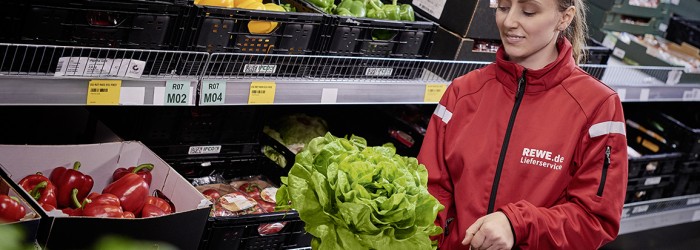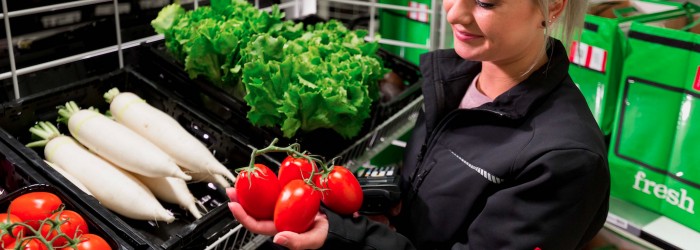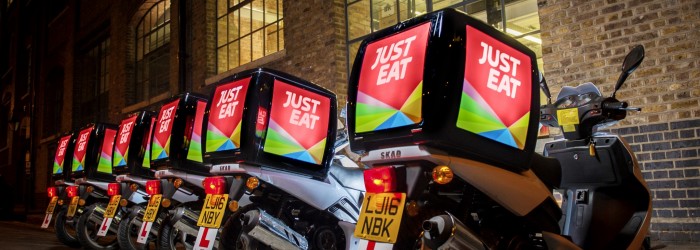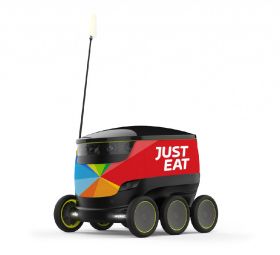
A single food distribution company that began life just under 18 years ago as a startup in a Danish basement is now worth more than all except the top ten grocery retailers in Europe. Just let that sink in for a moment. This company is now headquartered in the UK, active in 13 countries around the world and, despite only offering one service and no actual products of its own, has risen to become one of the most influential players in the European food market and a major influence on its millions of consumers. In November 2017, due to be listed among the top 100 companies on the London Stock Exchange, it was apparently worth £5.5bn – more valuable than the UK’s second-largest supermarket chain, Sainsbury’s.
The meteoric rise of JustEat, the web-based platform that enables people to order takeaway food from restaurants in their local area at the touch of a few buttons, neatly illustrates the power of the internet to take an area of the consumer economy and revitalise it by removing barriers to entry, improving the efficiency of its supply lines and making the experience for consumers and vendors alike far more convenient and rewarding. JustEat’s core markets now include Australia, Brazil, Canada, Denmark, France, Ireland, Italy, Mexico, Norway, New Zealand, Spain, Switzerland and the UK, with more apparently on the menu.
Across foodservice and indeed grocery retail, the impact of the internet is astounding and ongoing: opportunities have opened across the board for new players to tear down the walls of the bricks-and-mortar establishment, effectively stopping the once rampant traditional retail beasts in their real-estate-hungry tracks. Those real-world retailers have been forced to rethink their entire operations, in many cases curtailing investment in areas like new store openings and diverting their resources towards more modern forms of grocery distribution, like click-and-collect, home delivery networks and so-called dark stores whose entire raison d’être is to fulfil orders placed online.
In other parts of the world, such as China, where modern retail enterprises had not planted such deep roots in the market as the internet revolution began, some retailers like Alibaba-owned Hema have been able to leapfrog their older counterparts by incorporating online distribution more fully into their businesses, while other new market entrants have seen fit to do away with real-world retail altogether and focus solely on managing logistics networks in order to serve online customers.

Fresh investigation
In a marketplace that is increasingly globalised and interconnected, the way fresh fruit and vegetables are carried from origin to destination is changing, and the expansion of online distribution – spearheaded, of course, by Amazon – is at the heart of that change. The supply chain itself is in a continual state of flux, shaped and reshaped by the emergence of new markets and shifting patterns of consumer demand. As industry players right along that supply chain grow and consolidate, their advances are coinciding with a notable drive towards greater efficiency, a trend apparently being helped along by seemingly unstoppable technological advances.
With this in mind, the fresh produce industry’s leading trade fair Fruit Logistica has set about helping its visitors learn more about how the supply chain is changing and will change in future. To do so, the show’s cooperation partner Fruitnet Media International has commissioned global management consultancy Oliver Wyman to compile new and original research that explains what the fresh fruit and vegetable supply chain of tomorrow will look like. In a special report entitled 'Disruption in Fresh Produce Distribution', it will seek to answer these key questions: What are the most important factors affecting the global fresh produce supply chain? Where in the world will fresh fruit and vegetables be sold in 2025 and beyond? Which distribution channels will bring those products to consumers? And how will technology change that supply chain?
The findings of the research will be published for the first time in Berlin on 6 February during Fruitnet World of Fresh Ideas, one day before the start of Fruit Logistica. Drawing on original research conducted in the past few months, the report will present what its authors believe to be the potential impact on the fresh produce business of that online retailing trend, as well as innovations in cold chain logistics and technology, and new developments in foodservice.
Consumers in both established and emerging markets are evidently embracing e-commerce, which means their expectations are changing fast. While online-only retailers steal a march on their real-world rivals to offer faster delivery times, broader choice and greater convenience, some traditional supermarket retailers are working hard to counter that offer with an improved in-store experience and internet-based delivery services of their own. They may be past masters at providing the right quality fresh produce in store, but achieving that same standard in home delivery is by no means guaranteed.
For example, one of those European retail giants, Rewe Group, is pressing ahead with plans to expand its fresh food delivery service in Germany by building a new centre in Cologne for the fulfilment of online orders. Described as a ‘Food Fulfilment Center 2.0’, the new facility occupies a site the size of two and a half football pitches and is expected to be completed by the end of this year. It will be packed with state-of-the-art, automated technology that promises to bring Rewe up to speed as far as competing with the likes of Amazon.
Around 20,000 different products including fresh fruit and vegetables will be stored at the centre and, unlike previous distribution centres, those items will be moved automatically instead of by hand. “Previously, employees had to walk 12-15km per shift to complete orders,” explains Christoph Eltze, chief executive of Rewe Digital. “In the new FFC 2.0, it’s the other way round: here, the products come to the order picker simply and conveniently via automated shuttle technology.”
By this summer, the centre’s capacity to streamline grocery deliveries will begin to make a material contribution to Rewe’s retail operation. According to Jan Kunath, the deputy chairman of Rewe Group’s executive board who also heads up its digital business, the important thing will be to demonstrate that the same kind of freshness found in stores can also be guaranteed in the home delivery market. “Fresh food is a matter of trust for our customers,” he comments. “Freshness and quality play a key role for Rewe customers both on and offline. Especially with online orders, it is also about service and attractive offers, suitable delivery time-frames and efficient processes.”

Bricks and clicks
However, many observers feel the momentum is with the likes of US multinational Amazon and Chinese market leader Alibaba, the world’s largest e-commerce platforms. Online retail giant Amazon continues to roll out its AmazonFresh across Europe: in Germany, towards the end of 2017, it extended the service to Munich, bringing to three the number of urban locations in Germany where the group’s Prime members can count on same-day delivery of a range of fresh groceries including fruit and vegetables. That capped a busy year in the German market for the company, which rolled out AmazonFresh to customers in Hamburg last May, before doing the same for those in Berlin and neighbouring Potsdam in July.
Prime members in Munich and the immediate surrounding area can now choose from more than 300,000 items via the AmazonFresh website or the Amazon app, including products from popular local stores including independent grocer Frischeparadies. Delivery options are flexible Monday to Saturday – same-day when ordered before midday, or in two-hour delivery windows the next day.
'Our goal is to continually improve AmazonFresh,” says Ajay Kavan, the division’s vice-president. “The basis for this is customer feedback and our experience. We're learning more and more about it - in Berlin, Potsdam and Hamburg, but also in the US, UK and Japan. This should benefit all AmazonFresh customers, and from now [this is] also [the case] in Munich.”
One of the big new trends for 2018 will likely be an accelerated convergence of online and offline, something which in fact offers hope to those working in latter part of the market; after all, if Amazon feels the need to invest in bricks and mortar itself, as it has with its recent acquisition of Whole Foods, then presumably there are elements of the traditional retail experience that can remain as cornerstones of the real-world grocery offer.
In the past year, no doubt with an eye on the predicted growth of home grocery delivery, both Amazon and Alibaba have signalled their intention to extend their highly efficient distribution models to the physical realm in order to create closer links with communities: Amazon’s monumental takeover of Whole Foods brings it into even more direct competition with the likes of Walmart, while Alibaba’s stake in discount chain Sanjang Shopping Club suggests a similar development in China; the expansion of its Hema banner, meanwhile, shows no sign of slowing. One could argue that, with the internet giants entering the physical realm, the door is opening further for the fresh fruit and vegetable suppliers who can help these newer customers bring consistent supply into their stores.

Eating out is very much in
The recent push to remove unnecessary links in the fresh produce supply chain has reportedly had a dramatic effect, but not perhaps in the way people expected: the much-heralded introduction of simplified and highly efficient direct sourcing models, for example, has not always been as straightforward as predicted; and yet there is clearly huge demand from buyers around the world for greater directness and transparency.
So how is the logistics side of the supply chain managing to deliver on those requirements? How can it harness the enormous potential offered by new technologies like blockchain communications or vehicle automation? Which other technologies will be required? What role, moreover, will independent providers (the so-called 3PLs) play in helping the more traditional producer-exporter-importer model to adapt accordingly? And what will major structural changes to the supply chain – consolidation of container lines, for example, or the centralisation of physical distribution hubs – do to alter the distribution landscape in years to come?
Oliver Wyman’s report for Fruit Logistica will endeavour to find out. Companies new and old in the foodservice arena, where there is also plenty going on that could affect the fresh fruit and vegetable business, will also feature in the report. Online or offline, supermarkets may command the greatest attention when it comes to the international food business by virtue of their enormous buying power and close connection with consumers, yet the foodservice industry in some developed markets nowadays outperforms the retail trade when it comes to sales. A lot of the growth in this area is being generated by the newest kinds of delivery, including restaurant link-up services like JustEat, Deliveroo, Uber Eats or the Berlin-based global market leader Delivery Hero. Others, meal-kit provider HelloFresh (also based in Berlin) or the dedicated US grocery delivery company Instacart, are in many respects blurring the line between retail and foodservice.
These all represent opportunities that could offer the fresh fruit and vegetable business a growing source of income if the recent trends towards healthy eating, convenience and experiential enjoyment continue. However, the requirements in areas such as certification, lead times, product specifications or even the type of products needed might not necessarily be the same when it comes to this side of the food distribution market.
For that reason, the report will take a closer look at where in the foodservice arena new potential might lie for fresh produce companies, including those rapidly developing food-to-go and takeaway delivery trades. Will suppliers need to work more closely with third-party logistics providers in this market too? What about other foodservice areas like street markets, catering or public procurement? And in which areas should suppliers make changes to their product offering if they want to tap into this particular part of the chain?
Join us in Berlin to learn more…
Key findings from Fruit Logistica's special report 'Disruption in Fresh Produce Distribution' will be presented for the first time during Fruitnet World of Fresh Ideas, the annual curtain-raiser to Fruit Logistica.
Click here for more details and to register for Fruitnet World of Fresh Ideas.




